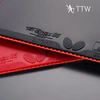
Commonly Used Wood in Table Tennis Rackets

A Table Tennis blade is the core of table tennis racket and their are various types of wood that are used in designing table tennis rackets. These days table tennis blade consist of various layers of wood and carbon to improve strength of the racket and reduce vibrations. Table tennis in general is considered a lightweight game but the right amount of strength is also important with the right amount of control to hit spins within a table.
Their are various types of blades with different layers and properties. Most commonly used blade are-
- 1 Layer all-wood Blade
- 3 layer all-wood Blade
- 5 layer all-wood blade
- 7 layer all-wood blade
- 3 Layer wood + 2 layer Carbon
- 5 layer wood + 2 layer carbon
SEE ALSO: Ideal Weight of a Table Tennis Racket
Commonly used wood in table tennis blades
Most of the commonly used wood in table tennis blades are-
Hinoki
A species of cypress native to central Japan. The wood is lemon-scented, light pinkish-brown, with a rich, straight grain, and is highly rot-resistant. Hinoki has the property of being very soft with a nice soft touch in short, but very fast when hitting. The biggest drawback is probably weight, that is apart from it’s scarcity and cost.
Balsa
Forest tree of lowland Central America. As it is low-density but high in strength, balsa is a very popular material to use when making light, stiff structures. It has a typical density of about 160 kg/m³. In blades Balsa is often combined with carbon + 2 outer plies of plywood, to make te blade light and fast at the same time.
Koto
The wood is tight and rather solid. It has a nicely striped, decorative design and therefore is often used as surface veneer (with a thickness of 0.7/0.8 mm)
Limba
A large tree in the family Combretaceae, native to tropical western Africa. The wood is either a light (‘white limba’) or with dark stripes (‘black limba’ or ‘korina’) hardwood. Limba has excellent acoustic properties, and so good vibrations which make this wood excellent for table tennis blades. The thinner veneers of limba that are being used in table tennis blades are popular for topspin game. The wood gives good acoustic click sound when used with softer rubbers and it’s vibrations or flex is liked by top spin players. The more the thickness, it increases the hitting ability.
Ayous
The high elasticity of this African wood gives quite a nice bounce effect when inside the blade. It is not that great a top veneer wood as it is not very pliable. Seemingly ayous is more often used in Asian blades, whereas Limba is used in European blades. There are exceptions though.
Kiri
A light weight, soft but very tight and torsionally stiff type of wood, mainly used as core veneer. Almost every Butterfly table tennis blade that is made in Japan has a Kiri core. More durable, heavier and harder than balsa. This is one of the main reasons why Butterfly blades are heavier than other manufacturer’s blades.
Spruce
Spruce is amazing ply that results in a good feedback and generates a unique sound when the ball is hit.
SEE ALSO: 5 Cheaper Alternative of Tenergy 05
Hybrid Blades
Hybrid blades use few layers of wood and an additional substance like carbon in the racket that acts as a catalyst and affects the properties of wood. Mostly to improve strength of the racket and reduce vibrations. Some of the rackets use Hybrid wood such as -
- Arylate
- Aramid
- Carbon
- Fiberglass
- ZL Carbon
Ooakforums(The properties of different types of wood) has a post on all the woods and properties that are used on modern day blades. You can read information about the properties of blade on Ooakforums about the properties of such woods.
Follow our Instagram - tabletenniscrunch or Twitter - TT_Crunch for interesting Table Tennis content.
⮜ Previous : How to Select a Beginner Table Tennis Racket
⮞ Next : Ideal Weight of a Table Tennis Racket
